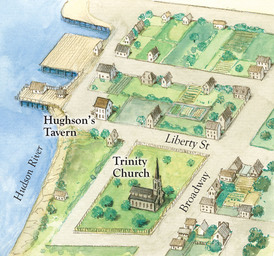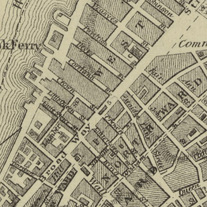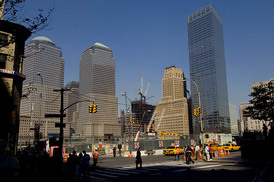Hughson's Tavern
In the spring of 1741, all eyes were on a tavern at the corner of Liberty and Trinity Streets. The tavern was on the waterfront then, and it was a meeting place for free and enslaved blacks as well as poor whites. It was illegal in those days for more than three slaves to meet unless they were working.
Trouble began after a burglary. The man charged with the crime was a slave called Caesar. When he was arrested at Hughson’s Tavern, investigators thought that John Hughson and his wife Sarah (who were white) were trading in stolen goods. Mary Burton, Hughson’s 16-year-old servant, was brought in for questioning. The investigators offered her a choice: She could tell all that she “knew” and gain freedom from being a servant, or go to prison. She chose the first option, and the Hughsons were quickly arrested. Then fires broke out—once there were four in one day. New Yorkers panicked, fearing the worst—another slave uprising. Again investigators turned to Mary Burton, and she again told them what they wanted to hear.
Mary claimed that Hughson’s Tavern was a meeting place for blacks and whites plotting to burn the city, murder its inhabitants, and seize power. The slaves would become masters, she said, and Caesar, the thief, would become governor. Her story was incredible, but it was believed. In the hysteria of “The Great Negro Plot” almost half of the adult black male population was arrested and brought to trial. In the end, 17 blacks were hanged, as well as the Hughsons and 2 other whites. Thirteen Africans were burned at the stake, and 70 enslaved blacks were shipped to the Caribbean to be resold.
This entry contributed by
Curriculum Concepts International
Related Media
Video

|
Columbia University Professor of History Kenneth Jackson describes Hughson's Tavern and the revolt of 1741.
|
Images

|
Today, the site of Hughson’s Tavern at the corner of Liberty and Trinity Streets is far from the waterfront. What was once the location of docks for ships is now the site of the former World Trade Center.
|

|
Hughson’s Tavern was on the waterfront in 1741. Its doors were open to blacks and poor whites, making it suspect during “The Great Negro Plot” of 1741.
|





